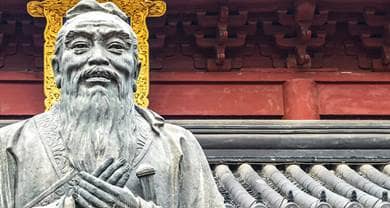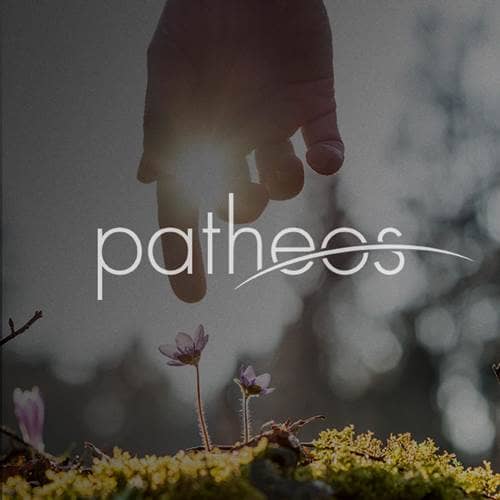- Trending:
- Easter
- |
- Lent
- |
- Forgiveness
- |
- Resurrection
- |
- Joy
- |
- Feminism

RELIGION LIBRARY
Confucianism
Rites and Ceremonies
Despite his disinterest in providing clear-cut answers to ultimate questions, Kongzi was a strong advocate for ritual. He believed that participation in ritual served to unite people and strengthen the human community.
The oldest and most enduring Confucian ritual practice is ancestor worship -- the ritualized commemoration of, communication with, and sacrifice to one's deceased relations. It is so pervasive in traditional East Asian religious life that one need not identify oneself as "Confucian" in order to practice it, even though its roots lie deep within the Confucian tradition. Just as to be Confucian is in some sense to be Chinese (or East Asian), to be Confucian indubitably entails participating in ancestor worship. Through the influence of Confucianism on China's neighboring cultures, Chinese norms for venerating deceased kin have spread across East Asia. In spite of recent repressions of traditional religious activity in mainland China and forceful trends toward modernization and secularization throughout East Asia, ancestor worship remains a vital component of community life in China, its surrounding region, and throughout the worldwide Chinese diaspora.
 Ancestor worship has been a vital part of Chinese life since prehistoric times. The earliest known Chinese writings document the practice of ancestor worship among the rulers of the Shang dynasty (1570-1045 B.C.E.). During the waning centuries of the Zhou dynasty (1045-221 B.C.E.), Confucians made ancestor worship the focal point of their moral and spiritual message. The Lunyu records several sayings of Kongzi on the importance of jing (reverence) for one's ancestors: "Observe what a person has in mind to do when his father is alive, and then observe what he does when his father is dead. If, for three years, he makes no changes to his father's ways, he can be said to be a good son" (Lunyu 1:11). Subsequent Confucian texts all refer to ancestor worship approvingly and commend it as a means of cultivating the virtue of filial piety (xiao) as well as instilling harmonious relations in society. It is not always clear whether classical Confucian authors maintained belief in the supernatural existence or power of ancestors, but their reverence for ancestor worship as a core element in the spiritual life is unambiguous.
Ancestor worship has been a vital part of Chinese life since prehistoric times. The earliest known Chinese writings document the practice of ancestor worship among the rulers of the Shang dynasty (1570-1045 B.C.E.). During the waning centuries of the Zhou dynasty (1045-221 B.C.E.), Confucians made ancestor worship the focal point of their moral and spiritual message. The Lunyu records several sayings of Kongzi on the importance of jing (reverence) for one's ancestors: "Observe what a person has in mind to do when his father is alive, and then observe what he does when his father is dead. If, for three years, he makes no changes to his father's ways, he can be said to be a good son" (Lunyu 1:11). Subsequent Confucian texts all refer to ancestor worship approvingly and commend it as a means of cultivating the virtue of filial piety (xiao) as well as instilling harmonious relations in society. It is not always clear whether classical Confucian authors maintained belief in the supernatural existence or power of ancestors, but their reverence for ancestor worship as a core element in the spiritual life is unambiguous.
With the rise of the Han dynasty (202 BCE-220 C.E.), which soon endorsed Confucianism as its official ideology, ancestor worship was incorporated into the systematic thought of the period, which both embraced cosmological notions about yin and yang (the dynamic, intertwined energies associated with darkness, receptivity, moisture, and femininity, on the one hand, and light, activity, aridity, and masculinity, on the other hand) and tended to project the bureaucratic structure of this world onto the next. Accordingly, human beings were thought to possess two distinct souls or spiritual essences. One, the hun, was identified with yang; light, ethereal, and intellectual, it was said to ascend and become an ancestor (zu) at death. By contrast, one's po soul -- dark, gravid, and sensual -- was supposed to remain with the entombed corpse and become a ghost (gui). Rites for the dead then became ways in which to guarantee that the deceased's hun and po separated properly and reached their appointed destinations; if family members displeased the dead or performed funerary rituals inadequately, they risked prompting the gui to leave the grave and wander, wreaking havoc on the living. Conversely, the failure to maintain reverence through ancestor worship could inspire the zu to abandon its advocacy for the living within the complex celestial bureaucracy envisioned by Han writings.
Archaeological and art-historical evidence suggests that, by the end of the Han dynasty, persons at nearly all levels of Chinese society regularly worshipped their ancestors. The goal of ancestor worship became ensuring that one's dead relations did indeed become ancestors, rather than ghosts: supernatural powers that were benevolent and remote, rather than malevolent and proximate. On this point, it is important to note that, beginning with Han texts, ancestors can be described as shen (spirits), a term that also means "gods." Indeed, the boundary between ancestors and deities is fluid, such that some ancestors became gods over time through promotion within the celestial bureaucracy. Confucians during this period often expressed skepticism about the particular beliefs associated with ghosts, gods, and ancestors, but never wavered in their support for the practice of worshipping these beings.
Despite the widespread practice of ancestor worship in ancient and medieval China, formalized ancestor cult was confined largely to the ruling classes through the Tang dynasty. It was not until the "Neo-Confucian" revival of the Song dynasty (960-1279) that elite practices such as detailed genealogical record-keeping and the construction of temples dedicated solely to ancestor worship became part of everyday life for commoners. Song emperors, who relied upon Confucian scholars to help stabilize and legitimize their regime, listened when Confucian thinkers such as Cheng Yi (1033-1107) advocated genealogical research and ancestral temples for non-elites. Later Confucian reformers, such as Zhu Xi devised ritual manuals that helped formalize and popularize ancestor worship among the lower classes. By the end of the Song dynasty, ancestor worship according to canonical Confucian procedures could be found at nearly all levels of Chinese society.

As the Song regime lost prestige and territory to non-Chinese powers -- such as the Jurchen peoples who overthrew Song rule in northern China in 1127, or the Mongols, who defeated the final Song emperor's forces in 1279 and ruled China as the Yuan dynasty until 1368 -- ancestor worship became one way in which to bolster Chinese ethnic and national self-confidence. By the late imperial period (from the founding of the Ming dynasty in 1368 to the fall of the Qing dynasty in 1912), ancestor worship had attained the form in which it is found today.
Like other aspects of Confucianism, ancestor worship was the target of severe criticism and persecution during the regime of Chinese Communist leader Mao Zedong (1893-1976), with parallels in North Korea and Vietnam. During the "Cultural Revolution" (1966-1976), in particular, popular Confucian rituals such as ancestor worship were suppressed by the state, and community venues for ancestor worship such as village temples were destroyed or used for secular purposes. The traditional practice of burying one's dead was condemned in favor of cremation; cemeteries were converted to agricultural uses. Zealous young students supervised the burning of home altars and ancestral tablets.
 The death of Mao relaxed, but did not end, government censure of ancestor worship. The Eleventh Party Congress of 1979 proclaimed that, although "certain long-standing activities such as ancestor worship" were "a kind of superstition," henceforth they would not be proscribed "as long as they do not affect collective political and economic activities," and that the government placed its faith in "patient persuasion and lasting education in science, culture, and atheism" to root out such practices eventually. Since the 1980s, both public and private ancestor worship have become more prominent in mainland China, and these practices have remained strong in Hong Kong and Taiwan as well as in overseas Chinese communities. Traditional Confucian ancestor worship continues unabated in South Korea, Vietnam, and Japan. Whether in mainland China, elsewhere in East Asia, or in the global East Asian diaspora, ancestor worship has never ceased to be practiced.
The death of Mao relaxed, but did not end, government censure of ancestor worship. The Eleventh Party Congress of 1979 proclaimed that, although "certain long-standing activities such as ancestor worship" were "a kind of superstition," henceforth they would not be proscribed "as long as they do not affect collective political and economic activities," and that the government placed its faith in "patient persuasion and lasting education in science, culture, and atheism" to root out such practices eventually. Since the 1980s, both public and private ancestor worship have become more prominent in mainland China, and these practices have remained strong in Hong Kong and Taiwan as well as in overseas Chinese communities. Traditional Confucian ancestor worship continues unabated in South Korea, Vietnam, and Japan. Whether in mainland China, elsewhere in East Asia, or in the global East Asian diaspora, ancestor worship has never ceased to be practiced.
Study Questions:
1. What is the most important Confucian ritual practice?
2. How do Confucians regard their ancestors?
3. Why is filial piety so important to Confucians?










